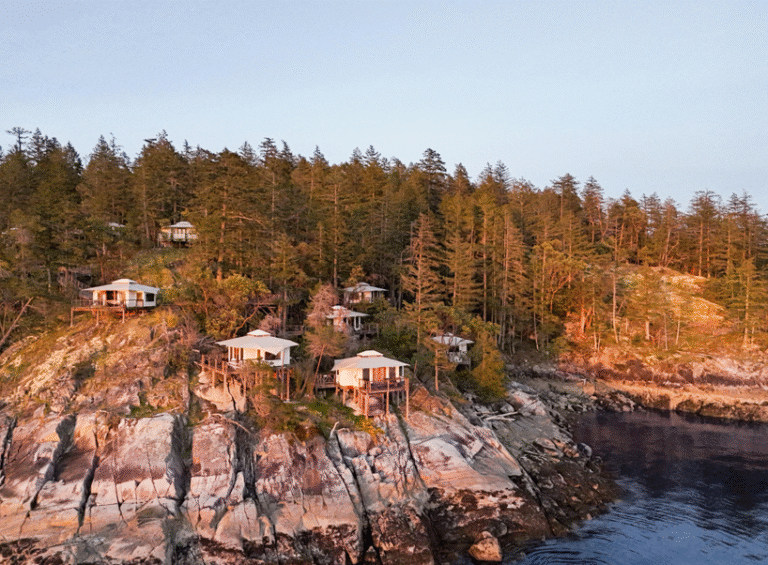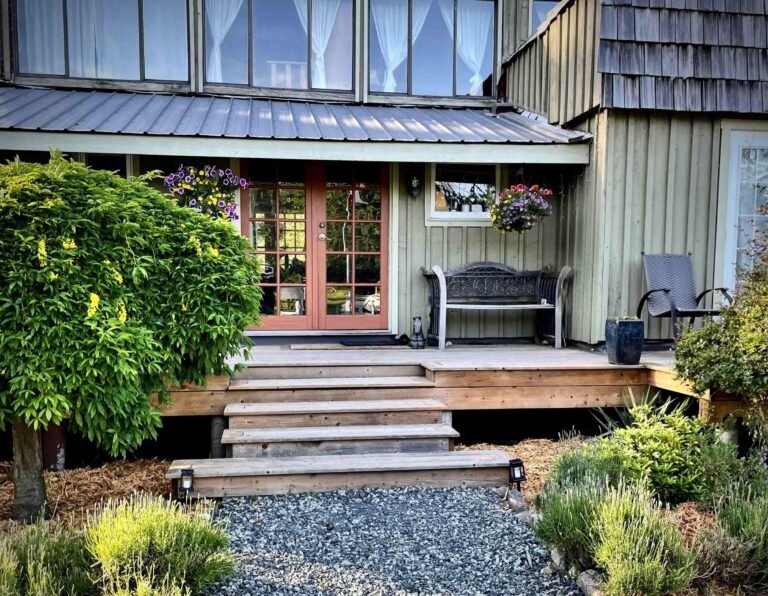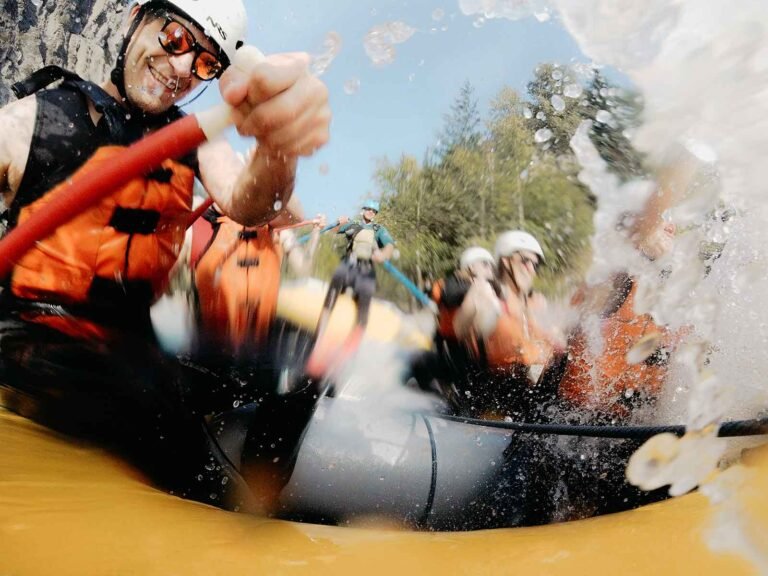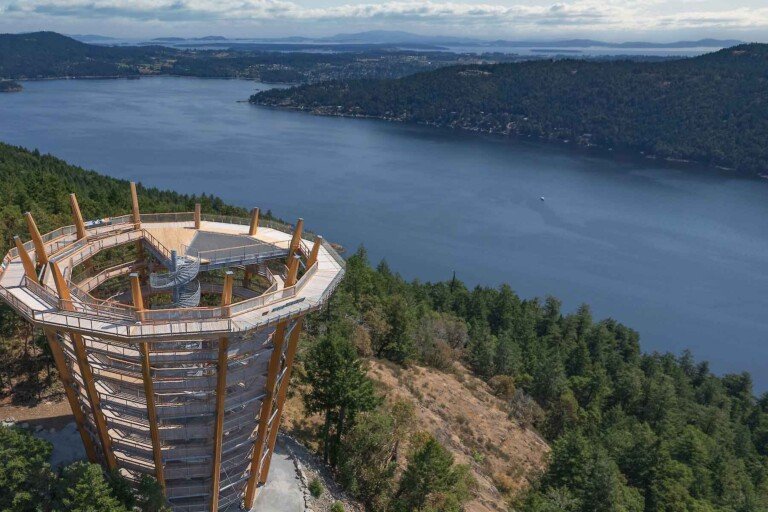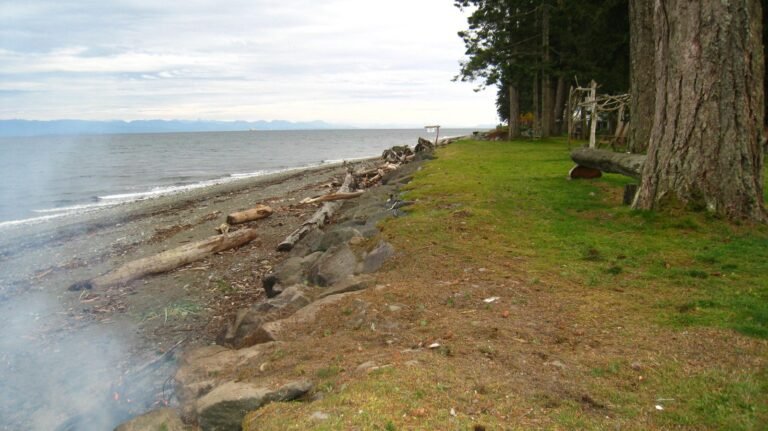Premier Listings: Canoeing & Kayaking: Greater Vancouver
Burrard Inlet lies both west and east of Stanley Park’s Prospect Point, where it is spanned by the Lions Gate Bridge at First Narrows. This aging, three-laned structure connects Vancouver with North and West Vancouver. The inlet expands into Coal Harbour, where much of the commercial marine activity is centred. It contracts again at Second Narrows where the Ironworkers Memorial Second Narrows Bridge links Vancouver and Burnaby on the south with North Vancouver on the north. Just beyond Second Narrows, Burrard Inlet divides and branches east to Port Moody and north up Indian Arm, a slender, steep-sided fjord.
Vancouver’s outer harbour is composed of English Bay and Burrard Inlet and acts as the holding area for large, oceangoing freighters. You often see as many as 20 ruddy-coloured ones floating high in the water as they await their turn to take on cargoes of prairie grain, lurid yellow sulfur, raw logs, sawdust, and finished lumber. When they come to load, each is guided to the inner harbour by a tugboat that possesses the muscle of a nightclub bouncer combined with the finesse of a ma”tre’d. Their antics are fun to watch from a beach or the Stanley Park Seawall trail. All this heavyweight activity allows very little room for recreation in the inner harbour, other than the rowers, whose sculls venture out at dawn and sunset from the Vancouver Rowing Club in Stanley Park. Strong currents that churn through First Narrows restrict small boats to the calmer waters except at slack tide.
Burrard Inlet does make a concession to recreation – it’s called False Creek. (In fact, False Creek is much more like a narrow bay. In England, the word ‘creek’ applies to a small indentation on the coast. Since it was named by Captain Richards of the Royal Navy in the late 1850s, we’ll have to live with it.) The ocean slips in under the Burrard Bridge and balloons past residential housing that in the past two decades has replaced the light industry that once soiled the shoreline. Gone are the battery recyclers with their lead and the barrel makers with their creosote. Ocean Cement is one of the last tenants of its kind here; its lease on Granville Island expired in 1999. The occasional tugboat still makes its way in and out of False Creek with a load of sand for the city works yard, but otherwise this sheltered backwater is the playground of kayakers and canoeists, and provides moorage for fishing boats at the federal dock and sheltered anchorage for sailboats. The Cambie Bridge arches above False Creek’s midpoint. The polished stainless-steel dome of Science World marks the creek’s eastern perimeter.
It’s easy to think that False Creek has always been the watery playground of the inner city. Most evenings, primarily from April to October, the sheltered finger of Burrard Inlet teems with a mix of canoes, dragon boats, kayaks, sculls, sailboats, tugboats, and stinkpots. Until the 1986 World Exposition on Transportation was held on its north shore, however, False Creek had been shabbily treated for decades. Its condition today as one of the cleaner waterways in Vancouver is a testimony to the recuperative powers of nature. Come see for yourself. You can launch your own hand-carried boat from the wharf in front of the False Creek Community Centre, 1318 Cartwright Street, on Granville Island. Head for the loading zone beside the centre’s Cartwright Street entrance, then carry your boat past the tennis courts and down the ramp to Alder Bay. From here it’s a steady 30-minute paddle to Science Centre at the east end of False Creek. It’s an equally long paddle west to Sunset Beach in the West End, though through choppier waters as you cross beneath the Burrard Bridge.
Barnet Marine Park has a paved driveway that can be used to launch canoes, kayaks, or sailboats in Burrard Inlet. No motorized boats can be launched from here. Belcarra Regional Park lies enticingly close across Burrard Inlet to the north. On a calm day, paddle over to explore the area around Belcarra’s Admiralty Point. Just be mindful of the occasional large freighter that may be gliding slowly into one of the nearby oil terminals. These big bullies can seriously ruin your day if they sneak up behind you.
If you’re looking for a place to begin a paddle on the Fraser River, Vancouver and Burnaby’s Fraser River Parks are two good sites to launch out onto the river in a hand-carried boat. If you have a day to spare, consider paddling between the two, a distance of about 7 miles (11 km) one way. In order to pull this off, you should arrange transportation between the two sites in advance. Leave a vehicle at each park or arrange to be picked up once you’ve completed your journey. The ideal time to run the Fraser is a Sunday morning when commercial traffic on the river’s North Arm is light. On weekdays, tugboats and other large vessels create a mishmash of wakes that might swamp an open canoe. Enjoy a few quiet hours on the Fraser, and you’ll thrill to the site of blue herons, sandpipers, and dabbling and diving waterfowl going about their business along the shore.
A thrill of a different kind is experienced as you pass beneath all of the major bridges that link Vancouver and Burnaby with Lulu and Sea Islands. If you’re fortunate to catch the tide flowing with you, a gentle current will carry you along. Check the tide tables in Vancouver’s daily newspapers to determine the optimum time to make this journey. Allow six hours to make the trip one way. Places to go ashore for a break include Vancouver’s Riverfront Park and Gladstone-Elliot Park. For an abbreviated adventure, you can paddle between one of these parks and Burnaby’s Fraser River Park, about 3 miles (5 km) round trip. You’ll miss much of the activity around the bridges, but will be spared having to arrange land transportation between sites. You can arrange to rent a canoe on Buntzen Lake – there is a boat launch (nonmotorized only) at the park’s South Beach.
One of the best ways to get a feeling for the Fraser Estuary is from a small boat such as a canoe or kayak. Although the Fraser River powers its way through the estuary in three main channels, there are numerous backwaters where the current is not as strong nor the wakes from passing tugboats and freighters as intimidating.
Try launching at Deas Slough and explore the nearby Ladner Marsh area. There are two approaches, one from Deas Island Regional Park and the other from the public boat launch at the north end of Ferry Road on the outskirts of Ladner. (Ladner, together with Tsawwassen to the south, is where the majority of Delta’s population resides.) Both approaches are equally well suited to exploring Deas Slough. Deas Island Park lies 1.5 miles (2.5 km) east of the Hwy 99/Hwy 17 interchange. A small causeway links the island with River Road. Car-top boats can be launched at the east end of Deas Slough beside the Delta Rowing Club. From here, the entire length of the slough stretches before you, an open invitation to steal away.
The boat ramp on Ferry Road at the west end of Deas Slough is vehicle accessible. This is where anglers, water-skiers, jet boats, canoes, and kayaks launch. To reach Ferry Road, take the Ladner exit immediately south of the George Massey Tunnel on Hwy 99. Drive west on River Road to Ferry Road. Turn east on Ferry and drive to the launch ramp. From here, Deas Island’s rocky-pointed snout is only a quick paddle away. The full girth of the Fraser River’s South Arm lies on the far side of Deas Island and should be paddled only at slack tide. During falling tides, currents in the Fraser can reach almost 7 miles (11 km) per hour, although you won’t experience these conditions in the backwater on Deas’ south side. The heart of the slough is equidistant from either Ferry Road or Deas Island Park. (Note: The gates at Deas Island Park close at 9pm; leave your vehicle outside them if you decide to linger longer than that. The short portage this necessitates is more than rewarded by the delight of drifting in the slough’s sleepy backwater as night falls – not to mention being able to drive your car at all.)
If you want to expand your journey beyond the slough, investigate the secluded channels of Ladner Marsh and the South Arm Marshes Wildlife Management Area that begins west of the Ferry Road boat launch and includes all of the delta between Deas and Westham Islands. There’s also a private marina beside the public boat launch on Ferry Road that provides private moorage.
There’s more to do at Crescent Beach in South Surrey than simply get sand between your toes. Although swimming is the big attraction in summer, you can launch a car-top boat and explore the coastline of Boundary Bay and Mud Bay, as well as the Nicomekl River, which channels into Boundary Bay east of Crescent Beach year-round. For larger boats, there’s a ramp just east of the Burlington Northern railway tracks in Crescent Beach. There’s also a drive-in boat launch nearby on the Nicomekl at Surrey’s Elgin Heritage Park on Crescent Drive near 35th Avenue.
Although there’s no boat launch at Semiahmoo Park, if you’ve arrived with a car-top boat or an inflatable raft, park as close to the end of the parking lot as possible, beside a baseball diamond. Launch in the nearby Campbell River and drift downstream from here. Note: Paddle out onto Semiahmoo Bay underneath a Burlington Northern Railroad bridge and gaze down through the clear water to the golden sand below. This is a dreamy location. Campbell River is intertidal, and thus more shallow at certain times than others.
One of the best ways to explore Surrey Bend Park is in a small boat. Use the boat launch beside the Barnston Island ferry slip at the foot of 104th Avenue and 176th Street in Surrey. Paddle west along Parsons Channel, hugging the south side of the Fraser River. Make your way into the park on Central Creek, which flows into the Fraser River at Surrey Bend a short distance west of the dock. Once in the backwaters of Central Creek, paddlers are guaranteed hours of enjoyment as they investigate its meandering course through shaded second-growth forest. This is a unique, West Coast river environment. As Surrey Bend was only given park status in 1995, there are few visitor services in place. For the moment, visitors are expected to make their own way around the park. What better natural path than a meandering creek?
Over the past decade, an increasingly large amount of land has been opened to the public as park in the region around Pitt Lake. Today, Grant Narrows, Widgeon Marsh, and Minnekhada Regional Parks straddle both sides of the Pitt River as it carries water from the intertidal lake to the nearby Fraser River. All of this abundantly rich land is the traditional territory of the Katzie people. The four reserves that they now occupy include one at the outlet of Pitt Lake adjacent to Grant Narrows. The recently created Pinecone Burke Provincial Park borders the reserve and encompasses much of the western side of the lake, while Golden Ears Provincial Park‘s boundary is the eastern shore.
It’s easy to see why the Katzie have always spent most of their time around the south end of the lake. In times gone by, sturgeon, salmon, and eulachon flourished in the river, while berries and wapato (a potato-like tuber) grew in the sloughs where ducks, geese, and sandhill cranes foraged. The abundance was staggering. Occasionally, a Katzie hunting party would venture up the east side of the lake in search of mountain goats. Only in summer do the surefooted animals descend the steep slopes of the fjord in search of drinking water. Ancient pictographs still visible on the sheer rock face above the southwest side of the lake detail such hunting scenes. Although you’d have to make like a goat to reach them, the red ochre shapes are clearly visible from the lakeshore.
Several superb locations await paddlers searching for freshwater adventure and wildlife in this region. From May to September there are canoes for rent at both Grant Narrows and Alouette Lake, so you don’t need your own boat to share in the experience. Grant Narrows Regional Park, at the south end of Pitt Lake, is the starting point for river exploration of a large, intertidal marsh that includes nearby Widgeon Creek. In Pitt Meadows, turn north off Hwy 7 at the Harris Road stoplights east of the Pitt River Bridge where a large sign points to Pitt Lake. Harris Road meanders north, then east. Turn north again at Neeves Road. Once across a narrow bridge over the Alouette River, the road becomes rougher and its name changes from Neeves to Rennie. Deep ditches line each side of the road as mountains begin to rise before you. You are now in Pitt Polder, travelling beside the broad Pitt River north towards Pitt Lake. Grant Narrows Park lies at the end of the road. Although Grant Narrows is a pocket-sized park, it serves as the gateway to several adjacent wilderness areas, such as the Pitt-Addington Marsh Wildlife Management Area. By far the most popular feature in the park is the boat launch. There is a charge for trailer-mounted boats; car-top boats launch for free. The Greater Vancouver Regional District has set aside a large area of the marsh at the mouth of Widgeon Creek, where it flows into the Pitt River, as a wildlife reserve. The GVRD offers seasonal nature programs that involve paddling in the Widgeon Marsh Reserve.
Widgeon Creek is the destination of choice for most paddlers who sprint across Grant Narrows to reach its protected backwater. The distance isn’t great, and it should take only 10 minutes of hard paddling to cross the open water. Strong winds spring up on nearby Pitt Lake in the afternoon and can kick up whitecaps that will intimidate novice paddlers. (Note: Paddling on Pitt Lake is not recommended because of the winds. Even experienced powerboaters on the lake treat it with respect.) A safe approach is to launch as early in the day as possible. In fact, to get the most out of your visit here, explore near sunrise or sunset when wildlife is most active and the scenery divine.
Widgeon Creek is helpfully marked by a wooden signpost that rises up above the water of the marsh. Follow upstream, bearing to the left early on where another signpost points towards the Forest Service recreation site located an hour’s paddle northwest of Grant Narrows. (If you follow the branch to the right, you enter a series of secluded backwaters perfectly suited for wildlife observation and fishing.) Late in the summer, when water levels are at their seasonal lows, you may have to hop out to float your canoe across a sandbar or two. Wear a pair of old running shoes that you can slip into and out of easily. The shoes will also come in handy when launching from Grant Narrows’ muddy shore.
You don’t have to venture far upstream before you find the first of many fine sandy areas, suitable for sunning and picnicking. Tall cottonwood, hemlock, and solitary Sitka spruce shade the shore as Widgeon lazily winds its way into the folds of the nearby mountains. A silence envelops you. The Forest Service recreation site features a rough canoe pullout beside a broad, grassy field, where both an old road and a trail begin. Follow either to reach Widgeon Falls. (The old road is a holdover from the days when miners followed this route north into the upper Pitt River valley. Today, it serves as the southern terminus of a lengthy 8-day hiking trail through Pinecone-Burke Provincial Park.) The hiking trail to Widgeon Falls (2.5 miles/4 km return) is a winding affair, with several steep staircases. The road leads gently uphill to the falls and covers approximately the same distance as the trail, but for the most scenic approach, take the trail as it follows emerald-hued Widgeon Creek for half of the journey. Widgeon Falls tumbles over and through a series of smooth granite boulders. When water levels drop, it’s possible to walk out on the rock shelf beside the creek for a better look. On sunny days you may even find a small pool for a quick dip. The best feature of the falls is the relentless, roaring white noise it emits, a powerful sound that clears and cleanses the mind.
Rather than follow the crowd to Widgeon Creek, take advantage of the log booms that line the Pitt River and float south along its banks. The booms help cut the wake of passing motorboats. Osprey nest on the tops of the mooring posts. In these quiet waters you’ll have the best chance of observing them, as well as herons, swans, and perhaps even exotic sandhill cranes, whose nesting ground lies nearby in the polder. (Polders are low-lying sections of land near rivers and oceans, dried by using a technique perfected in Holland.) Cross over to explore the backwaters along the western side of Siwash Island, which conceals the true riverbank at the foot of Mount Burke. The channel between the two is shallow. In summer, the wild smell of marsh marigolds in bloom perfumes the air.
If you’re fortunate enough to get a ride up Pitt Lake on a powerboat that also has room to carry or tow your canoe or kayak, June is the best time to spend a few hours exploring the intertidal waterways of Red Slough at the north end of Pitt Lake. That’s when water from freshets, combined with semi-annual high tides, makes navigation easiest. Broad arms of the slough invite paddlers back into the folds of the mountains. Lurid yellow lichen cling to the glistening, black granite walls, creating an effect as striking as an abstract expressionist painting.
Kanaka Creek Regional Park in Maple Ridge is a long corridor of protected land that stretches almost 7 miles (11 km) inland from the Fraser River. To explore the park by canoe or kayak, head for the car-top boat launch in a section of the park located near Kanaka and the Fraser’s confluence. TakeHwy 7 (Lougheed Hwy) a short distance east of Maple Ridge. Just after the highway crosses the Kanaka Creek Bridge, a green GVRD sign indicates the way to Kanaka Creek Regional Park’s Riverfront entrance. Turn south onto River Road, cross the railway tracks, and drive to the west end of the parking lot. The boat launch is located a short distance from here. You can spend an idyllic 30 minutes paddling a mile or so upstream to a fish counting station beside the 240th Street Bridge (only open from October through mid-December). Shallow water north of here choked with blowdowns makes paddling more difficult – better to float back downstream through Kanaka’s oxbow bends with your binoculars at the ready. Lazily explore the last few bends made by Kanaka between the boat launch and the Fraser. The atmosphere in this section is one of protective solitude, with only a hint ofa breeze. Tall stands of evergreens and cottonwoods shade much of the creek. From their branches, hawks eye the herons who have flown across from their colony in Derby Reach Regional Park. Thick stands of green vegetation are so perfectly mirrored in the creek’s languid surface that at times it is difficult to tell where the true growth leaves off and the reflection begins. In places along the creek, mauve, helmet-shaped penstemon flowers tower above the shoreline.
Golden Ears Provincial Park’s Alouette Lake provides a big-lake paddling experience. Head for the day-use area where a drive-in boat launch is nestled beside the picnic area. Canoe and kayak rentals are available at lakeside from June to September. The best time to explore the length of the 10-mile (16-km) lake is early or late in the day. Strong winds often arise at midday, which make paddling a tough proposition. As Alouette is a flooded lake (there’s an unobtrusive earthen dam at its south end), the forest descends to the waterline. You’ll find only a few good landing spots in case of trouble; the lake’s east side is particularly rough.
If you wish to explore the less-visited northern half of Alouette Lake, you can save yourself an hour or more of paddling time by portaging your canoe or kayak from the Gold Creek parking lot to North Beach. A service road leads from the parking lot to a dock at the beach, a 15-minute hike. As you approach Moyer Creek two prominent features stand out on the skyline, Mounts Nutt and Gatey. You’ll find much to admire as you paddle north towards wilderness campsites at Moyer Creek, a two-hour, 2.5-mile (4-km) paddle one way. In summer, several small beaches stand revealed on the lake’s west side, perfect places to pause for a break in the paddling while you enjoy a dip.


